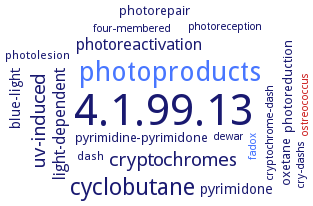4.1.99.13: (6-4)DNA photolyase
This is an abbreviated version!
For detailed information about (6-4)DNA photolyase, go to the full flat file.

Word Map on EC 4.1.99.13 
-
4.1.99.13
-
photoproducts
-
cyclobutane
-
uv-induced
-
cryptochromes
-
photoreactivation
-
light-dependent
-
pyrimidone
-
blue-light
-
photorepair
-
oxetane
-
pyrimidine-pyrimidone
-
photoreduction
-
photolesion
-
dash
-
ostreococcus
-
four-membered
-
fadox
-
photoreception
-
cry-dashs
-
dewar
-
cryptochrome-dash
- 4.1.99.13
- photoproducts
-
cyclobutane
-
uv-induced
-
cryptochromes
-
photoreactivation
-
light-dependent
-
pyrimidone
-
blue-light
-
photorepair
-
oxetane
-
pyrimidine-pyrimidone
-
photoreduction
-
photolesion
-
dash
- ostreococcus
-
four-membered
- fadox
-
photoreception
- cry-dashs
-
dewar
- cryptochrome-dash
Reaction
Synonyms
(6-4) DNA photolyase, (6-4) photolyase, (6-4) PHR, (6-4) PL, (6-4) PP-specific PL, (6-4)-Phr, (6-4)photolyase, 6-4 DNA photolyase, 6-4 photolyase, 6-4CiPhr, 6-4PP-photolyase, animal (6-4) photolyase, At64, At64PHR, bacterial (6-4) photolyase, CmPHR1, Cry1, CryB, deoxyribodipyrimidine photolyase-related protein, Dm64, DNA photolyase, Ds64PHR, H64PRH, human (6-4) photolyase homologous protein, NF-10, OtCPF1, phr (6-4), PhrB, PL-(6-4), prokaryotic (6-4) photolyase, RSP_3077, TRIREDRAFT_77473, XELAEV_18035355mg, Xl64phr
ECTree
Advanced search results
Crystallization
Crystallization on EC 4.1.99.13 - (6-4)DNA photolyase
Please wait a moment until all data is loaded. This message will disappear when all data is loaded.
purified recombinant PhrBI51W mutant, is crystallized by hanging drop vapor diffusion method, mixing of 5 mg/ml protein in 12.5 mM Tris, 1.25 mM EDTA, 2.5% w/v glycerol, and 75 mM sodium chloride, pH 7.8, with reservoir solution containing 5% PEG 400 and 100 mM 2-(N-morpholino) ethanesulfonic acid, pH 6.5, in a 1:1 ratio, X-ray diffraction structure determination and analysis at 2.15 A resolution, molecular replacement using the wild-type PhrBWT structure, PDB ID 4DJA, as the initial search model. Purified recombinant PhrBY424F mutant is crystallized by sitting drop vapor diffusion method, mixing 0.004 ml of 4-6 mg/ml protein in 12.5 mM Tris, 1.25 mM EDTA, 2.5% w/v glycerol, and 75 mM sodium chloride, pH 7.8, with an equal volume of reservoir solution containing 5% w/v PEG 400, 100 mM 2-(N-morpholino) ethanesulfonic acid, pH 6.0, and equilibration against 1 mLl of reservoir solution at 16°C, in darkness, 3-7 days, X-ray diffraction structure determination and analysis at 2.50 A resolution
purified recombinant His-tagged enzyme, hanging drop vapor diffusion method, mixing of 0.005 ml of protein in 12.5 mM Tris (hydroxymethyl) amino methane, 1.25 mM EDTA, 2.5% v/v glycerol, 75 mM sodium chloride, pH 7.8, with 0.005 ml of reservoir solution containing 2-6% w/v PEG400, 100 mM 2-(N-morpholino) ethanesulfonic acid buffer, pH 6.0, 25°C, 3-7 days, X-ray diffraction structure determination and analysis at 1.45-1.95 A resolution
determination of a crystal structure of Drosophila melanogaster (6-4) PL (Dm64) bound to a 15-mer DNA duplex containing a central T(6-4)T lesion
T(6-4)C lesion containing DNA duplex in complex with the (6-4) photolyase, by the hanging-drop vapour diffusion method, at 18°C, to 2.95 A resolution. Lesion is flipped out of the opened DNA duplex into the active site of the enzyme
-
to study how the enzyme recognizes the T(6-4)C and T(Dew)C lesion analogues in the active site, DNA duplexes are crystallized together with the (6-4) photolyase
two crystal structures of the (6-4) photolyase bound to lesion containing DNA before and after repair, repair does not involve oxetane formation before light-induced electron transfer. The histidine 369, supposed to activate the acylimine, is in a position that does not allow efficient proton donation and hence activation of this substructure
-


 results (
results ( results (
results ( top
top





